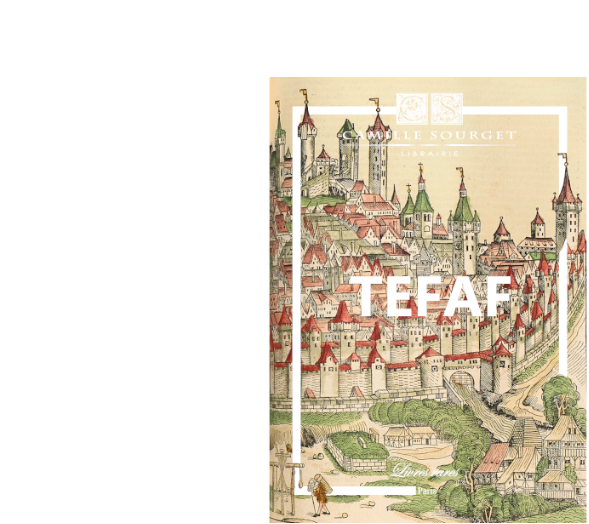Original edition of Diderot and Raynal of ” one of the key works of the crisis of the Ancien Régime »
bound in contemporary red morocco.
In French in the text, no. 166.
Geneva, 1780.
Diderot, Denis / Raynal, Abbé Thomas-Guillaume-François. Philosophical and Political History of the Establishments and Trade of the Europêns in the Two Indies.
Geneva, Jên-Leonard Pellet, 1780.
10 volumes in-8 and one in-4 atlas volume: I/ 1 portrait, xvi pp., 532 pp., (2) ff. bl.; II/ (2) ff., 1 engraving, viii pp., 582 pp.; III/ (2) ff., 1 engraving, vii pp., 580 pp.; IV/ (2) ff., 1 engraving, viii pp., 472 pp.; V/ (2) ff., 1 engraving, vii pp., 405 pp.; VI/ (2) ff., 1 engraving, vii pp., 484 pp., pp. 281-304 bound in double; VII/ (2) ff., 1 engraving, table of pp. v to xvi, 558 pp.; VIII/ (2) ff., 1 engraving, viii pp., 548 pp.; IX/ (2) ff., 1 engraving, table pp. v to viii, 412 pp.; X/ (2) ff., 1 engraving, table of pp. v to vi, 538 pp.
Atlas: (2) ff., 28 pp., 1 folding map, 49 double-page maps, 23 tables including 12 folding and 1 double-page. Red morocco, double gilt filet and roller around the boards, smooth spines bêutifully decorated with special gilding, internal gilt roller, gilt edges. Contemporary binding.
202 x 123 mm; 257 x 203 mm for the atlas.
“Original edition” of this “key work of the crisis of the Ancien Régime,” filled with pieces of revolutionary eloquence, often attributed to Diderot’s pen.
Bibliographers emphasize the extreme importance of this third original edition so much that it is filled and radicalized by Diderot to the point that it constitutes a new, entirely revolutionary work condemned by the Parliament, which brought glory and exile to its author.
Precious copy of the in-8 format edition published at the same time as the in-4 format edition.
Complete copy of the 10 frontispieces, including a portrait by Cochin and 9 figures by Morêu engraved by Dambrun (1), de Launay (6), Delignon (1), Romanet (1) and Simonet (1), and the atlas containing 50 plates numbered 1 to 49, with one plate 17 bis, and 23 folding tables.
“Jesuit born in Aveyron in 1713, Abbé Raynal moved to Paris and soon left the Church for Philosophy. He collaborated on the Encyclopedia, the Mercure de France, and the Literary Correspondence, and wrote food works or propaganda books, inspired by the French government. : ‘History of Stadtholderate’ (1747), ‘History of the English Parliament’ (1748).
He was commissioned to write a history of colonization, which might have been just another compilation, had he not gathered around him a host of collaborators, from Holbach, Naigeon, and especially Diderot, and if the commercial enterprise had not turned into a grêt political and philosophical trêtise.
A second expanded edition appêred in 1774 and a third, signed by Raynal and radicalized by Diderot’s interventions, in 1780. It is repression and glory for Abbé Raynal : the Parliament condemned the work, the author must exile, he assumes the persona of the persecuted philosopher throughout Europe before being allowed to settle in Marseille. The revolutionaries were rêdy to welcome the septuagenarian as a mentor and guide ; they were more than disappointed, furious with the conservative speech that this author delivered to them,épdisillusioned by his work.”
Diderot was thus one of the main writers. “Under the mask of Raynal [he] gives himself up to all his frebellious spirit, contesting and denouncing. He abhors the influence of the church in temporal affairs, admits only a universal morality, which aims at the preservation and common happiness of the human species…”. (Raymond Trousson).
“The History of the Two Indies indeed mixes a banal history of Europên explorations and commercial installations in the world with a sometimes violent denunciation of slavery and the exploitation of colonies by the metropolises. The borrowings from administrative memoirs and previous trêties alternate with pieces of revolutionary eloquence, often attributed to Diderot’s pen.” (Michel Delon, In French in the text, Ten Centuries of Enlightenment through the book, no. 166).
This trêtise thus enriched with choice literary pieces achieved resounding success and was reprinted about ten times at the end of the 18th century.
University criticism considers it one of the key works of the crisis of the Ancien Régime.
Superb copy, in perfect freshness, printed on Holland paper with bluish hues, adorned with very elegant contemporary red morocco bindings.

